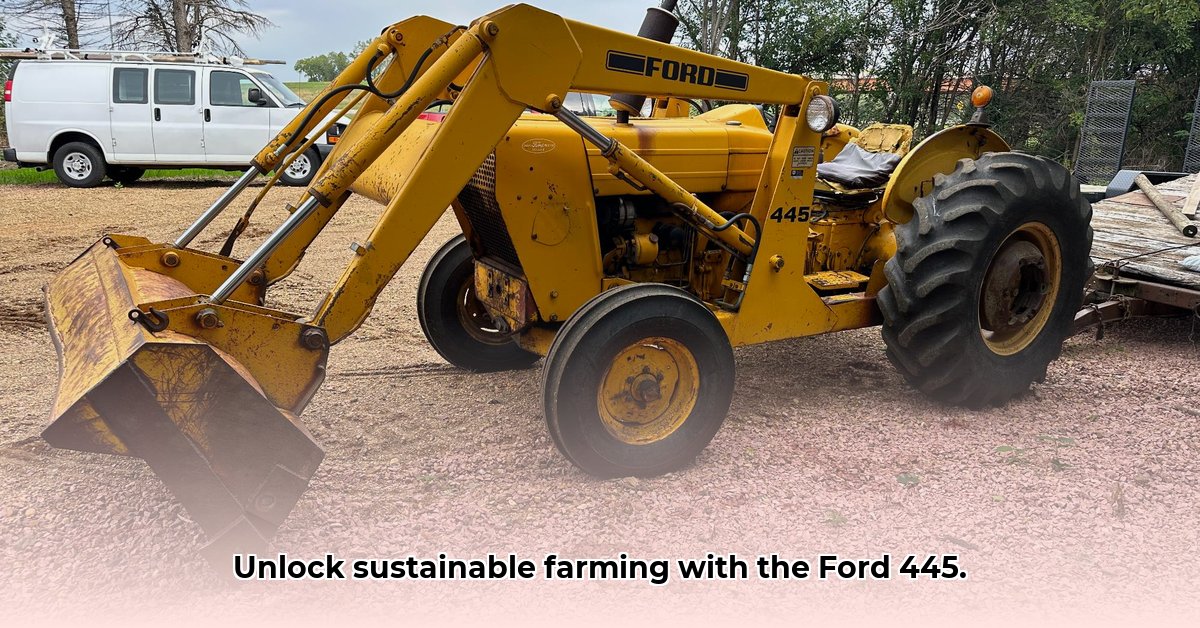
The Ford 445 tractor, a stalwart of the agricultural landscape from 1979 to 1983, presents a compelling case study in the intersection of vintage machinery and modern sustainable farming practices. This guide examines its capabilities, limitations, and overall suitability for contemporary agricultural needs, focusing on its potential role within a sustainable farming context. Is this robust machine a viable investment for today's environmentally conscious farmer, or a relic of a bygone era? Let's analyze this question. For more information on Ford 4000 series tractors, see this helpful resource: Ford 4000 specs.
Technical Specifications and Operational Characteristics
The Ford 445, boasting 47-52 horsepower, provided a significant work capacity for its time. Three transmission options—6-speed, 8-speed, and a 4-speed with torque converter—offered farmers considerable operational flexibility (although these options lack modern technological advancements). Its hydraulic system, a standard open-center design (less efficient than modern closed-center systems), proved reliable for many common farming tasks. The 16-gallon fuel tank, while sufficient for a day's work depending on the tasks, highlights the significant fuel efficiency differences between vintage machinery like this and modern equivalents. This disparity in fuel efficiency is a crucial factor in any sustainability assessment.
Market Value and Current Demand
The Ford 445 remains surprisingly present in the used tractor market, commanding prices ranging from roughly $6,800 to over $20,000, depending on condition and operating hours. This enduring demand suggests a niche market likely comprising smaller farms or those with specific needs met by this robust, older machine. However, this lingering market presence must be analyzed with regards to the tractor's ability to meet the demands of modern, sustainable farming.
Sustainability Assessment: Environmental Impact
While the relatively low initial cost of a Ford 445 is appealing, its age presents substantial environmental concerns. Older diesel engines typically exhibit lower fuel efficiency and higher pollution levels compared to modern counterparts. A key often-overlooked metric is fuel consumption per acre worked. This precise data is critical for determining the true environmental cost of using such a tractor. Can the potential economic benefits outweigh the higher fuel consumption and greater emissions? This requires a detailed cost-benefit analysis tailored to specific farming operations.
Cost-Benefit Analysis: Should You Buy a Ford 445?
Deciding whether a Ford 445 aligns with your agricultural goals requires a thorough evaluation of various factors:
- Acquisition Cost: While the initial price is lower than newer models, potential repair and maintenance costs must be factored in, which can significantly offset initial savings.
- Fuel Efficiency: Prepare for higher fuel consumption, leading to increased operating expenses and a larger carbon footprint. Modern tractors often show fuel efficiency improvements of 20-30% or more.
- Parts Availability and Cost: Sourcing parts and servicing a vintage tractor can prove more challenging and expensive.
- Emission Compliance: Confirm that the tractor meets current emission standards; non-compliance may result in penalties.
Modern Farming Applications: Defining a Sustainable Niche
The Ford 445 may find a niche in certain farming contexts. Small-scale, organic operations, where affordability might outweigh absolute fuel efficiency, may find it suitable. However, a complete lifecycle cost analysis, considering long-term sustainability and environmental impact, is indispensable before making a purchasing decision.
Future Trends in Farm Machinery: A Long-Term Perspective
The future of farm machinery emphasizes increased efficiency and reduced environmental impact. While the Ford 445 might serve specific needs, it’s unlikely to remain a sustainable long-term solution for most farmers. The trend toward cleaner, more efficient equipment compels informed decision-making.
Ford 445 Tractor: A Summary Table
| Factor | Advantages | Disadvantages |
|---|---|---|
| Purchase Price | Lower initial investment | Higher potential for long-term maintenance costs |
| Fuel Efficiency | Relatively simple mechanical design | Significantly lower fuel efficiency than modern equivalents |
| Parts Availability | Some parts may still be available | Parts sourcing can be difficult and expensive |
| Emission Compliance | Possibly compliant with some older standards | May not meet modern environmental regulations |
Reducing Emissions from a Used Ford 445 Tractor: Practical Strategies
Minimizing the environmental impact of a Ford 445 involves strategic maintenance and potential upgrades. This section outlines practical steps to achieve this goal.
Optimizing Fluid Usage
Correct fluid management is key to reducing emissions. Using the correct oil, hydraulic fluid, and coolant (meeting or exceeding manufacturer's specifications) is crucial for optimal performance and minimizing fuel consumption. Improper fluids increase friction, leading directly to increased emissions.
Leveraging Funding Opportunities
Several funding programs, such as California's FARMER program 1, offer financial incentives for emissions reductions in agricultural equipment, although the process may involve navigating bureaucratic steps.
Long-Term Sustainability Planning
Long-term sustainability strategies include planned equipment replacements and continuous learning about advancements in sustainable agriculture.
Key Takeaways:
- Proper fluid maintenance is crucial to optimize performance and reduce emissions.
- Regularly explore funding opportunities for upgrades.
- Strategically plan for equipment replacements to transition to more efficient models.
- Continuous learning is essential to stay informed about advancements in sustainable agricultural practices.